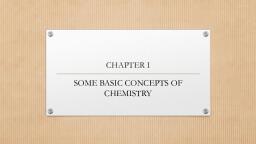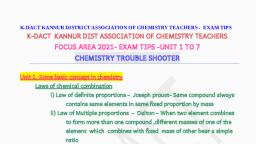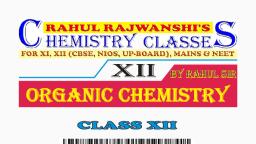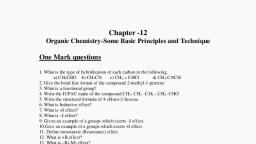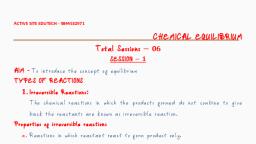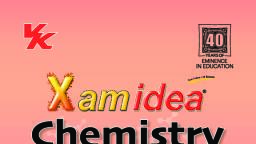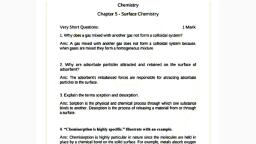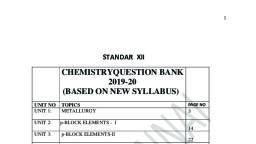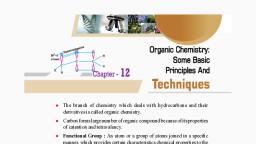Page 1 :
TELANGANA STATE BOARD OF, INTERMEDIATE EDUCATION, , CHEMISTRY 2nd YEAR, (English Medium), BASIC LEARNING MATERIAL, ACADEMIC YEAR, 2020-21
Page 3 :
PHYSICS - I, , 2, , PREFACE, The ongoing Global Pandemic Covid-19 that has engulfed the entire world has changed, every sphere of our life. Education, of course is not an exception. In the absence of Physical, Classroom Teaching, Department of Intermediate Education Telangana has successfully, engaged the students and imparted education through TV lessons. The actual class room, teaching through physical classes was made possible only from 1st February 2021. In the, back drop of the unprecedented situation due to the pandemic TSBIE has reduced the, burden of curriculum load by considering only 70% syllabus for class room instruction as, well as for the forthcoming Intermediate Public Examinations May 2021. It has also, increased the choice of questions in the examination pattern for the convenience of the, students., To cope up with exam fear and stress and to prepare the students for annual exams in, such a short span of time , TSBIE has prepared “Basic Learning Material” that serves as, a primer for the students to face the examinations confidently. It must be noted here that,, the Learning Material is not comprehensive and can never substitute the Textbook. At, most it gives guidance as to how the students should include the essential steps in their, answers and build upon them. I wish you to utilize the Basic Learning Material after you, have thoroughly gone through the Text Book so that it may enable you to reinforce the, concepts that you have learnt from the Textbook and Teachers. I appreciate ERTW Team,, Subject Experts, Medha Charitable Trust who have involved day in and out to come out, with the, Basic Learning Material in such a short span of life., I would appreciate the feedback from all the stake holders for making it enriching and cent, percent error free in all aspects., The material can be accessed through our website www.tsbie.cgg.gov.in which is exclusively, devoted to uploading the additional study material from time to time., , Commissioner &Secretary, Intermediate Education, Telangana.
Page 4 :
26, , INTERMEDIATE CHEMISTRY-II, , Contents, Unit - 1, , Solid State, , 01 - 02, , Unit - 2, , Solutions, , 03 - 06, , Unit - 3, , Electro Chemistry and Chemical Kinetics, , 07 - 12, , Unit - 4, , Surface Chemistry, , 13 - 14, , Unit - 5, , p-Block Elements, , 15- 18, , Unit - 6, , d & f Block Elements and Coordination, Compounds, , 19- 20, , Unit - 7, , Biomolecules, , 21 - 23, , Unit - 8, , Organic Chemistry, , 24 - 25
Page 5 :
INTERMEDIATE CHEMISTRY-II, , 1, , SOLID STATE, , 1, , , VERY SHORT ANSWER QUESTIONS (2 MARKS), 1., Ans., , 2., Ans., , 3., Ans., 4., Ans., , 5., Ans., 6., Ans., 7., Ans., , State Schottky and Frenkel Defects., Schottky Defect: It is basically a vacancy defect in ionic solids. To, maintain electrical neutrality the number of missing cations and anions, is equal., Eg:AgBr, NaCl, Schottky defect decreases the density., Frenkel Defect: It is a point defect due to the smaller ion (usually, cation) is dislocated from its normal site to an interstitial site., eg:AgBr,AgCl, Frenkel defect does not decrease the density., What are amorphous substances? Give examples., The solid substances which have no orderly arrangement of particles, are called as amorphous substances., Eg : glass, rubber, plastic., What makes a glass different from quartz?, Glass is amorphous in nature and quartz is crystalline in nature., What is meant by the term coordination number?, The number of nearest oppositively charged ions surrounding a particular ion is called, coordination number., Eg : Coordination number of Na+ in NaCl lattice is 6., What is the coordination number in cubic close pack structure?, In cubic close-pack structure, coordination number is 12., What is coordination number in body-centered cubic structure., In body-centered cubic structure, coordination number is 8., How do you distinguish between crystal lattice and unit cell?, Crystal lattice, Unit cell, i) The three dimensional regular, i) The simple unit of crystal lattice, arrangement of constituent particles, which when repeated again and again, of a crystal is called crystal lattice., gives the entire crystal lattice is called, unit cell.
Page 6 :
2, , 8., Ans., 9., Ans., 10., Ans., , INTERMEDIATE CHEMISTRY-II, , How many lattice points are there in one unit cell of face centered cubic lattice?, In one unit cell of face centered cubic lattice, no of lattice points = 14, How many lattice points are there in one unit cell of body centered cubic lattice?, In one unit cell of face body centered cubic lattice, no. of lattice points = 9, Explain why ionic solids are hard and brittle., Because of ionic bonds (electro static forces of attraction) ionic solids are hard and brittle., SHORT ANSWER QUESTIONS (4 MARKS), , 1., Ans., , Explain the similarities and differences between metallic and ionic crystals., Similarities between metallic and ionic crystals :, i) There are electrostatic forces of attractions, ii) Bonds are non-directional., Differences between metallic and ionic crystals :, Metallic crystals, Ionic crystals, i) Electrostatic forces of attraction, i), Electrostatic forces of attraction, are in between valence electrons, are between oppositely charged ions., ii) Good conductors of electricity in, ii) Good conductors of electricity in, solid state, molten state, iii) Metallic bond may be weak or strong, iii) Ionic bond is strong, , 10., , Derive Bragg's equation., , Ans., , Derivation of Bragg's equation :, From the figure we can observe that 2nd ray travels more distance than the 1st ray i.e,AB+BC., According to Bragg's analysis the different rays striking the two layers of atoms are in phase, initially. But they can be in phase after relfection, only if the extra distance AB + BC is equal to, a whole number of wavelengths n ., AB+BC = nλ ___________(1), , In the ΔABZ, Sinθ =, , AB, BZ, , BZ = d, , AB, d, AB = d sinθ, , Sinθ =, , as AB = BC, AB +BC = 2d sinθ___________(2), , From equation (1) and (2), , nλ = 2d sinθ, This equation is called Bragg's equation.
Page 7 :
INTERMEDIATE CHEMISTRY-II, , 3, , SOLUTIONS, , 2, , 1., , VERY SHORT ANSWER QUESTIONS (2 MARKS), What is a solution?, , Ans. The homogeneous mixture of two or more components is called solution., 2., , Define the term Molality?, Molality : The number of moles of solute present in 1 kg solvent., Molality of a solution , , 3., , number of moles of solute, weight of solvent (in kg), , What is ppm of Solution?, , Ans: ppm (Parts per million) :, ppm , , 4., , No. of parts of the component, 10 , Total no. of parts of all components of the solution, , Define the term Mass percentage?, , Ans. Mass percentage of a component =, 5., , Mass of the component in the solution, × 100, Total mass of the solution, , What is Volume percentage ?, , Ans. Volume percentage of a component =, 6., , volume of the component, 100, Total volume of solution, , State Raoult’s Law., , Ans. The relative lowering of vapour pressure of a dilute solution having non-volatile solute is equal, to the mole fraction of the solute., (OR), The partial vapour pressure of each component of the solution is directly proportional to its mole, fraction present in solution., 0, , p1 p1, x2 or p1 x1, 0, p1, p10 = vapour pressure of pure solvent, p1 = vapour pressure of solution, x2 = mole fraction of solute, x1 = mole fraction of solvent
Page 8 :
4, , 7., , INTERMEDIATE CHEMISTRY-II, , State Henry’s Law., , Ans. The partial pressure of the gas in vapour phase (p) is proportional to the mole fraction of the gas, (x) in the solution., p = KH x, p = partial pressure of the gas in vapour phase, KH = Henry’s law constant, x = mole fraction of the gas, , 8., , What is Molarity?, , Ans. The number of moles of solute present in 1 litre solution is called Molarity., 9., What are ideal solutions? Give example., Ans. The solutions which obey Raoult’s law over the entire range of concentration are known as ideal, solutions., eg: n.hexane and n.heptane, benzene and toluene, 10. What are isotonic solutions?, Ans: Two solutions having same osmotic pressure at a given temperature are called isotonic solutions., eg: Saline solution and blood., 11. What is osmotic pressure?, Ans. The excess pressure which is applied on the solution to prevent osmosis is called osmotic, pressure. = CRT, T, 12. What is reverse osmosis? Give its application., Ans. When pressure is larger than the osmatic pressure, then pure solvent flows out of the solution into, solvent through the semi permeable membrane is known as reverse osmosis., It is used in desalination of sea water., 13. What is elevation of boiling point?, Ans. The increase in the boiling point of the solution by addition of non volatilie solute to the pure, solvent is called Elevation of Boiling point., , Tb Tb Tb0, 14. What is ebullioscopic constant (Kb)?, Ans. The elevation in boiling point of the one molal solution containing a non-volative solute is called, ebullioscopic constant., 15. What is cryoscopic constant (Kf)?, Ans. The depression in freezing point of one molal solution containing a non-volatile solute is called, cryoscopic constant.
Page 9 :
INTERMEDIATE CHEMISTRY-II, , 5, , SHORT ANSWER QUESTIONS (4 MARKS), 1., What is mole fraction ? Calculate the mole fraction of H2SO4 in a solution contaning, 98% H2SO4 by mass, Ans. The ratio of number of moles of one component to the total number of moles of all the components, present in the solution is called mole fraction of that particular component., Number of moles of the component, Total number of moles of all the components in the solution, Assume that we have 100 g of solution., Mole fraction of a component =, , No. of moles of water nH 2O = 2/18 = 1/9 = 0.111, No. of Moles of H2SO4 nH 2 SO 4 = 98/98 = 1, nH 2 SO 4, 1, , 0.9, Mole fraction of H2SO4 = n n, 0.11 1, H 2O, H 2 SO 4, , 2., , Calculate the mole fraction of ethylene glycol in a solution containing 20% of C2H6O2, by mass., Ans. Assume that we have 100 g of solution., Solution will contain 20 g of ethylene glycol and 80 g of water., Molar mass of C2 H 6O2 2(12) 6(1) 2(16) 62 g mol 1, No. of moles of C2 H 6O2 , No. of moles of H 2O , , 20, 0.322 mol, 62, , 80, 4.444 mol., 18, , Mole fraction of ethylene glycol , , , 3., , No. of moles of C2 H 6O2, No. of moles of C2 H 6O2 No. of moles of H 2O, , 0.322, 0.068, 0.322 4.444, , A solution of glucose in water is labeled as 10% w/w. What would be the molarity, of solution?, , Ans. 10% w/w glucose solution : 10g of glucose in 100g solution weight of solvent (water) = 100 - 10, = 90g, Volume of solution = 90 mL ( density of water = 1 g / mL), weight of glu cos e, 1000, , G.M.wt. of Glu cos e Vol. of solution, 10 1000, , , 0.617M, 180, 90, , Molarity of solution
Page 11 :
INTERMEDIATE CHEMISTRY-II, , 7, , ELECTRO CHEMISTRY AND, CHEMICAL KINETICS, , 3, , , VERY SHORT ANSWER QUESTIONS (2 MARKS), 1., , Define molar conductivity Λ m and how is it related to conductivity (k) and the molarity, (c) of the solution?, , Ans. Molar conductivity of a solution at a given concentration is the conductance of Vml of the solution, containing one mole of electrolyte kept between two electrodes separated by unit length and, area of cross section A., Relation between molar conductivity m and conductivity (k) :, m k, Relation between molar conductivity m and molarity (c) :, 1, c, What is Nernst equation?, m , , 2., , m , , k, c, , , M(s), Write the equation for an electrode with Mn+(aq) + ne– , , Ans. Nernst equation relates the reduction potential of an electro chemical reaction to the standard, electrode potential, temperature and activities of chemical species under going reduction and, oxidation., M n (aq) ne , M(s), , EMn / M E0Mn / M , , [M] , 2.303RT, log n , nF, [M ] , , E M n / M E Mn / M , 0, , 3., , 1 , 0.059, log n , n, [M ] , , Calculate the E cell of the following reaction., 0, Mg(s) + 2Ag+(0.0001M) Mg+2 (0.130M) + 2Ag(s) ( Ecell, = 3.17 V ), , Ecell E, , 0, cell, , 3.17 , , Mg +2 , 0.059, log, 2, n, Ag + , , 0.059, 0.130, log, 2, (0.0001) 2, , = 3.17 - 0.21 = 2.96 V.
Page 12 :
8, , 4., , INTERMEDIATE CHEMISTRY-II, , State Faraday’s First law of electroylsis. A solution of CuSO4 is electrolysed for 10, mintures with a current of 1.5 amperes. What is the mass of copper deposited at the, cathode?, Faraday’s First Law: The amount of substance deposited/liberated, at an electrode during, electrolysis is directly proportional to the quantity of current (electricity) passing through the, electrolyte., (OR), The amount of chemical reaction which occurs at any electrode during electrolysis is proportional, to the quantity of current passing through the electrolyte., At.wt. C t, m = valency 96500, , m=, 5., , 6., , 7., , 63 1.5 600, 0.2938 g, 2 96500, , State Farday’s second law of electrolysis., Faraday’s Second Law:, The amounts of different substances liberated, when the same quantity of current is passing, through the electrolytic solution are proportional to their chemical equivalent weights., m1 : m2 : m3 = E1 : E2 : E3, State Kohlrauch’s Law and write its applications?, Limiting molar conductivity of an electrolyte can be represented as the sum of the individual, contributions of the anion and the cation of the electrolyte., On dissociation if an electrolyte gives V+ cations and V– anions., 0m v 0 v 0, (i) 0m for any electrolyte from 0 of individual ions can be calculated., (ii) Dissociation constants of weak electrolytes can be determined., Define rate of reaction. Give its units., The change in the concentration of a reactant or product per unit time called rate of reaction., , R P, r, , d R d P , , dt, dt, , units : mol L1S1, 8., , Give two examples for zero and first order reactions?, zero order, First order, , i), , 1130k, 2NH 3 (g) , N 2 (g) + 3H 2 (g), Pt catalyst, , ii), , Au, 2HI , H 2 I2, , i), , C2H4(g) +H2(g) C2H6(g), , ii), , 1, N 2 O5 (g) , N 2 O 4 (g) O 2 (g), 2
Page 13 :
INTERMEDIATE CHEMISTRY-II, , 9., , 9, , Mention the expressions for rate constants for zero and first order reactions., Zero order reaction:, , R 0 R , , x, t, t, First order reactions:, , k=, , R 0, 2.303, log, t, R, , k=, 10., , 11., , or k=, , (or) k =, , 2.303, a, log, t, (a x), , Mention the units of rate constants of zero and first order reactions., Units of rate constant for zero order reactions: mol L-1 s-1, Units of rate constant for first order reactions : s-1 (Or) time-1, What is half-life t 12 of a reaction? Derive the equations for the half-life value of zero, order and first order reactions., Half life t 12 of a reaction : The time in which the concentration of a reactant is reduced to, one half of its initial concentration is called half life of the reaction., Zero order reactions:, Derivation of Half-life, k, , R 0 R , t, , At t = t1/2 , R =, k, , R 0, 2, , R 0 1/ 2 R 0, t1/ 2, , R 0, , a, 2k, 2k, First order reactions:, , t1/2 =, , k=, , or t1/2 =, , R 0, 2.303, log, t, R, , Derivation of Half-life, at t1/2 R =, , R 0, , 2, so the above equation becomes, , k=, , R 0, 2.303, log, t1/2, R 0 /2, , Or t1/2 =, , 2.303, log 2, k
Page 14 :
10, , INTERMEDIATE CHEMISTRY-II, , t1/2 =, , 2.303, 0.301, k, , 0.693, k, A reaction has a half-life of 10 mintues. Calculate the rate constant for the first order, t1/2 =, , 12., , reaction., k, , , 0.693, t1/ 2, , 0.693, 0.0693min 1, 10, SHORT ANSWER QUESTIONS (4 MARKS), , 1., , State order and molecularity of the reaction. Write the differences between them., Order of reaction: The sum of powers of the concentration terms of the reactants in the rate, law expression or rate equation is called as order of reaction., Molecularity of reaction: The No. of molecules or atoms or ions which participate in elementary, step or rate determining step of reaction is called Molecularity., Molecularity, Order, 1), It is always a whole number., 1) It may be 0, 1, 2, 3 or a fraction, (1 or 2 or 3), 2), It is determined from reaction, 2) It is determined from experimental results., mechanism., 3) It is applicable for elementary, 3) It is applicable for both elementary and, rections only., complex reactions., LONG ANSWER QUESTIONS (8 MARKS), , 1., , What is Arrhenius equation? Derive an equation which describes the effect of rise of, rise of temperature (T) on the rate constant (k) of a reaction., Ans: Arrhenius equation : The equation which explains the temperature dependence of the rate of a, chemical reaction is called Arrhenius equation., e Ea/RT, ................(1), k = rate constant, A = Arrhenius factor, E a = activation energy, R = gas constant, T = absolute temperature, taking natural logarithm on both sides, we get, kA, Where
Page 15 :
INTERMEDIATE CHEMISTRY-II, , n k , , Ea, nA, RT, , 11, , .........(2), , at T T1 , k k1, n k1 , , Ea, n A, RT1, , .......(3), , at T T2 , k k 2, Ea, n A, .........(4), RT2, Subtracting eq (3) from eq (4) we get,, n k 2 , , n, , k 2 Ea 1 1 , , , k1 R T1 T2 , , log, , intercept =ln A, , ln k, , k2, Ea 1 1 , , , k1, 2.303R T1 T2 , , eq (2) can be written as, log k log A , , E a, 2.303RT, , Slope = -, , Ea, R, , 1/T , , .............(5), , eq (5) is in the form of y = mx + c, log k is taken on y-axis and, , 1, on x-axis, a straight line is, T, , obtained having slope E a / 2.303R and intercept log A., 2., , For a chemical reaction with rise in temperature by 100, the rate constant is nearly doubled., Explain the following terms., (a) Average rate of a reaction, (b) Slow and fast reactions, (c) Activation energy of a reaction., (a) Average rate of a reaction: The average rate is the change in concentration over of a, selected period of time., (b) Slow reactions: The reactions which proceed slowly are called slow reactions., Example : Rusting of iron., Fast reactions: The reactions which proceed fastly are called fast reactions., Example : Reaction between sliver nitrate and sodium chloride., (c), Activation energy : The difference between threohold energy and average energy, possessed by reactants is activation energy.
Page 16 :
12, , INTERMEDIATE CHEMISTRY-II, , 4., Explain the factors effecting rate of reaction., Ans. 1., Nature of Reactants The reactions between ionic substances are faster than that of, covalent compounds., In covalent compounds for breaking old bonds and for making new bonds some time is, required. It is not required for the reactions between ionic substances., 2., Effect of concentration of reactants: According to Law of Mass Action the rate of, reaction is directly propotional to the product of molar concentrations of reactants. Hence, by increasing the concentration of reactants the rate of reaction increased., 3., Effect of temperature: By increasing the temperature rate of reaction increases. By, increasing the temperature by 10 degrees the rate of reaction increases to almost two, times. Because number of collisions between reactant molecules per unit time per unit, volume increases., 4., Effect of catalyst : The rate of reaction increases in presence of catalyst. Because the, reaction proceeds in the path of less activation energy in the presence of catalyst.
Page 17 :
INTERMEDIATE CHEMISTRY-II, , 4, , 13, , SURFACE CHEMISTRY, , , 1., Ans., , 2., Ans., 3., Ans., , 4., Ans., 5., Ans., , 6., Ans., 7., Ans., 8., Ans:, , VERY SHORT ANSWER QUESTIONS (2 MARKS), Distinguish between adsorption and absorption. Give one example of each., Adsorption: The accumulation (or) concentration of a substance on the surface rather than in the, bulk of solid (or) liquid is known as adsorption., Eg: O2, H2 on charcoal., Absorption: The uniform distribution of a substance through out the bulk of the solid substance, is known as absorption., Eg: Chalk stick dipped in ink., What is sorption?, In case of some substances both adsorption and absorption takes place. This phenomenon is, called sorption., What are micelles? Give one example., Some substances which at low concentrations behave as normal strong electrolytes, but at high, concentrations exhibit colloidal behaviour due to formation of aggregates. The aggregated particles, thus formed are called micelles., Eg. Stearate ions ( associate together in high concentration, in a solution of soap in water and, forms a micelle., What is Peptization?, The process of converting a precipitate into colloidal sol by shaking it with the dispersion medium, in the presence of a small amount of electrolyte is called Peptization., What is dialysis ? How is dialysis can be made fast?, The process of removing a dissolved substances from a colloidal solution using a suitable membrane, is called dialysis., Dialysis is made faster by applying an Emf. This is known as Electrodialysis., What is Tyndall effect ?, When light passes through a colloidal solution we will be able to see the path of the light as a, luminous beam. This is called Tyndall effect., What is Brownian movement., Zig-zag motion of colloidal particles is called Brownian movement., State Hardy – Schulze rule., Greater the valence of the coagulating ion added, the greater is its power to cause coagulation., This is known as Hardy – Schuze rule.
Page 18 :
14, , INTERMEDIATE CHEMISTRY-II, , SHORT ANSWER QUESTIONS (4 MARKS), 1., What are different types of adsorption ? Give any four differences between characteristics of these different types., Ans., Physisorption, Chemisorption, 1. It arises because of van der Waals’ forces. 1. It is caused by Chemical bond formation., 2. It is not specific in nature., 2. It is highly specific in nature., 3. It is reversible in nature., 3. It is irreversible in nature., 4. It depends on the nature of gas., 4. It also depends on the nature of gas., Easily liquefiable gases are adsorbed readily. Gases which can react with the, adsorbent shows chemisorption., 5. Enthalpy of adsorption is low, 5. Enthalpy of adsorption is high., (20-40KJ/mole), (80-240KJ/mole), 6. Low temperature is favourable for, 6. High temperature is favourable for, adsorption., adsorption., It decreases with increase of temperature., It increases with the increase of, temperature., 7. No appreciable activation energy is, 7. High activation energy is sometimes, needed., needed., 8. It results into multi molecular layers on, 8. It results into unimolecular layer only., adsorbent surface under high pressure., 2., What are lyophilic and lyophobic sols? Compare the two terms interms of stability and, reversibility., Ans: Lyophilic sols - There is more attraction between dispersed phase and dispersed, medium, Lyophobic sols - There is less attraction between dispersed phase and dispersed medium., Lyophilic sols are stable and not easily coagulated. They are reversible sols. Lyophobic sols are, unstable and they are easily coagulated. They are irreversible sols.
Page 19 :
INTERMEDIATE CHEMISTRY-II, , 15, , p-BLOCK ELEMENTS, , 5, , , VERY SHORT ANSWER QUESTIONS (2 MARKS), 1., , What is Allotropy? Give the Allotrops of phosphorous., , Ans: An element exists in different physical forms with same chemical properties is known as allotropy., Allotropic forms of phosphorous are white, red and black., 2., , Nitrogen exists as diatomic molecule and phosphorus as P4- Why ?, , Ans: 1), , Due to smaller atomic size Nitrogen form one - bond and two -bonds i.e. triple bonds, with other nitrogen atom and exist as di atomic molecule., , 2), , Due to large atomic size P is unable to form -bonds with another P atom and so it is tetra, atomic in which each atom is linked with three P atoms by three -bonds., , 3., , What is tailing of mercury? How is it removed?, , Ans: Ozone reacts with mercury and gives Hg2O. Due to the dissolution of Hg2O in Hg, mercury loses, its miniscus and starts sticking to the sides of the glass (container) called ‘tailing of mercury’., 2 Hg + O2 Hg2O., It is removed by shaking it with water., 4., , Give the sturctures of XeO3and XeF2., , Ans. XeO3 : Pyramidal, XeF2 : Linear, 5., , How XeOF4 is prepared? Write its structure., , Ans: On partial hydrolysis of XeF6 gives XeOF4, XeF6 H2O XeOF4 2HF, Square pyramidal shape., 6., , Write the reaction between fluorine and water?, , Ans: Fluorine reacts with water gives oxygen., , 2 F2 2 H 2O 4 HF O2, 7., , Noble gases are inert – explain., , Ans: Noble gases are inert because they have completely filled valancy shell.
Page 20 :
16, , INTERMEDIATE CHEMISTRY-II, , SHORT ANSWER QUESTIONS (4 MARKS), 1., , How is nitric acid manufactured by Ostwald’s process?, , Ans: Catalytic oxidation of NH3 by atmospheric oxygen gives NO., Pt, 4 NH 3 ( g ) 5O2 ( g ) , 4 NO ( g ) 6 H 2O ( g ), 500 K ,9 bar, , Nitric oxide combines with oxygen and gives NO2, 2 NO ( g ) O2 ( g ) 2 NO2 ( g ), , Nitrogen dioxide dissolves in water to give HNO3., 3 NO2 (g) + H2O (l) 2 HNO3 (aq) + NO, 2., , How are XeF2 and XeF4 prepared? Give their structures., , Ans. a), , Excess xenon reacts with flourine and forms XeF2, 673 K ,1bar, Xe F2 , XeF2, In 1:5 ratio xenon and fluorine react each other to form XeF4, 873 K , 7 bar, Xe 2 F2 , XeF4, , (1:5 ratio), , Linear, (OR), , Square Planar, (OR), , LONG ANSWER QUESTIONS (8 MARKS), 1., , How is ammonia manufactured by Haber’s process? Explain the reactions of ammonia, with, a) ZnSO 4(aq ), , b) CuSO 4( aq ), , c) AgCls , , Ans. Ammonia is manufactured by Haber's process based on Lechatelier's principle., N2 (g) 3H2 (g), , , , 2NH3 (g) ; H 92KJ (exothermic), , According to Lechatelier's principle, the optimum conditions are, Pressure: 200-500 atm, Temperature: 725-775k, Catalyst: Iron oxide + small amount of K2O and Al2O3, Promotor : Molybdenum
Page 21 :
INTERMEDIATE CHEMISTRY-II, , 17, , Reactions of ammonia :, a) Zn SO 4 (aq), , : Zn SO 4 2 NH 4 OH Zn(OH) 2 (NH 4 ) 2 SO 4, , b) CuSO 4 (aq ) : CuSO 4 4 NH 3 (aq ) Cu (NH3 )4 SO 4, c) AgCl(S) : AgCl 2 NH 3 (aq) Ag(NH3 ) 2 Cl(aq), , Uses of NH3 :, i) To produce various nitrogenous fertilizers, ii) To prepare many inorganic nitrogen compounds, iii) As a refrigerant., 2., How is ozone prepared? How does it react with the following ?, (a) PbS, (b) KI, (c) NO, (d) Ag, (e) C2H4, Ans: Ozone preparation : Oxygen when passed through a silent electrical discharge conversion of, oxygen to ozone (10%) occurs. The product is called ozonised oxygen., 3O 2 , 2O 3 ; H 142KJ / mole -1, a) PbS : Ozone react with lead sulphide and gives lead sulphate., , b), , PbS 4O3 , PbSO4 4O2, KI : Ozone reacts with moist KI to give iodine., , c), , 2KI H 2O O3 , 2KOH I 2 O 2, NO : Ozone oxidises nitric oxide to nitrogen dioxide., NO O3 , NO 2 O 2, , d), , Ag : Ozone reacts with silver and forms silver oxide., 2Ag O3 , Hg 2 O O 2, , e), , C2H4 : Ozone reacts with C2H4 to form ethylene ozonide which on hydrolysis gives formaldehyde., O, C 2 H 4 O3 , CH 2, , O, 3., , H 2O/Zn, CH 2 , 2HCHO H 2O 2, , O, , How is chlorine prepared in laboratory and by Deacon’s method? Explain its reaction, with, a) hot, conc. NaOH and cold, dil. NaOH, , b) Excess NH3 and excess Cl2 with NH3, , c) Na2S2O3, , e) Fe, , d) Ca(OH)2, , f) H2S, , Ans: Preparation of chlorine by laboratory method :, a), , Chlorine is prepared by heating manganesedioxide with concentrated hydrochloric acid., MnO2 4 HCl MnCl2 Cl2 H 2O
Page 23 :
INTERMEDIATE CHEMISTRY-II, , 6, , , 19, , d AND f BLOCK ELEMENTS AND, COORDINATION COMPOUNDS, VERY SHORT ANSWER QUESTIONS (2 MARKS), , 1., , Calculate the ‘spin only’ magnetic moment of Fe2+(aq) ion., , Ans. n(n 2), , as n 4, 4(4 2) 4(6) 24 4.9 BM, 2., , Write electronic configuration of Zn2+ and Mn2+?, , Ans: Electronic configuration of Zn2+ is 1s 2 2s 2 3 p 6 3s 2 3 p 6 4s 0 3d 10 (OR) Ar 18 4 s 0 3d 10 and it has, only paired electrons., Electronic configuration of Mn2+ is 1s 2 2s 2 3 p 6 3s 2 3 p 6 4s 0 3d 5 (OR) Ar 18 4s 0 3d 5 and it has, (five) unpaired electrons., 3., , Why Zn2+ is diamagnetic whereas Mn2+ is paramagnetic?, , Ans: In Mn+2 ions unpaired electrons are present in d orbitals. In Zn+2 ions unpaired electrons are not, present in d orbitals., 4., What is ligand?, Ans: Coordinating entity (ion or molecule) that is bound to the central atom by donating electron pairs., eg: Cl , Br , I , SCN , CN , NO3, 5., , 6., , CuSO4.5H2O is blue in colour where as anhydrous CuSO4 is colourless. Why?, In CuSO4.5H2O, water acts as ligand, as a result it causes crystal field splitting. Hence it exhibits, blue colour., In anhydrous CuSO4 due to absence of H2O crystal field splitting is not possible. So it exhibits no, colour., Give two examples of Catalysts of d-block elements., , Ans: Vanadium oxide (V2O5) in contact process , finely divided iron in Haber’s process, nickel in, Catalytic Hydrogenation., 7., , What is lanthanide contraction?, , Ans: The regular decrees in atomic radii of lanthanides is called lanthanide contraction., SHORT ANSWER QUESTIONS (4 MARKS), 1., , Explain Werner’s theory of coordination compounds with suitable example., , Ans: 1., , In co-ordination compounds metal ions show two types of valences – primary and secondary., , 2., , The primary valences are satisfied by negative ions. Whereas secondary valances are satisfied, by neutral molecules as well as negative ions.
Page 24 :
20, , INTERMEDIATE CHEMISTRY-II, , 3., , Every metal ion has a fixed number of secondary valences called coordination number., , 4., , The ions / neutral molecules bound by the secondary valences have characteristic spatial, arrangements corresponding to different coordination numbers, such spatial arrangements, are now called coordination polyhedra., , Eg: 1. In CoCl3.6NH3 Primary valence is 3; Second valence is 6, 2., 2., , In CoCl3.5NH3 Primary valence is 3; Second valence is 6, , Using IUPAC norms write the systematic names of the following, (i) [Co(NH3)6]Cl3, , (ii) [Pt(NH3)2Cl(NH2CH3)]Cl, , (iii) [Ti(H2O)6]3+, , (iv) [NiCl4]2–, , Ans. (i), , Hexa amine Cobalt(III) chloride, , (ii) Dia ammine chloro methanamine Platinum(II) chloride, (iii) Hexa aqua Titanium(III) ion, (iv) Tetrachloro Nickelate(II) ion, 3., , Explain the following, (a) Ambidentate Ligand, , (b) Co-ordination number, , (c) Co-ordination entity, , (d) Central metal atom/ion, , Ans. a), , Ambidentate Ligand: The wigent which contain two possible donor atoms is called, Ambidentate Ligand., Eg. NO2, CN, , b), , Co-ordination number : The number of coordination bonds with which the ligands are, bound to central ion., , c), , Co-ordination entity: One in which a central metal atom or ion is bound by a fixed, number of ions or molecules., , d), , Central metal atom/ion: The atom/ion to which a fixed number of ions/groups are bound, in a definite geometricalarrangement around it.
Page 25 :
INTERMEDIATE CHEMISTRY-II, , 21, , BIOMOLECULES, , 7, , , VERY SHORT ANSWER QUESTIONS (2 MARKS), 1., , What is Zwitter ion? Give an example., In aqueous solution amino acids lose proton from carboxyl group and amino group can accept a, proton giving rise to a dipolar ion known as zwitter ion. Eg. Glycine, O, O, ||, ||, R – CH – C – O – H, , , , , , , |, :NH2, , +, , CH2, , , , R – CH – C – O–, |, NH3, , , , COO, , NH3, , SHORT ANSWER QUESTIONS (4 MARKS), 1., , Define carbohydrates. How are the carbohydrates classified on the basis of their, (a) Taste, , (b) Hydrolysis, , (c) Functional groups, , Ans: Optically active polyhydroxy carbonyl compounds or molecules which provide such units on, hydrolysis are called carbohydrates. Ex: Glucose, Sucrose, Cellulose., (a), , (b), , Classification based on taste into, , i), , Sugars, , ii) Non-sugars, , i), , Sugars : Sweet carbohydrates are called sugars. Ex : Glucose, Lactose, Sucrose, , ii), , Non-sugars : Carbohydrates without sweets are called non sugars. Ex : Cellulose,, Starch, Glycogen, , Classification based on hydrolysis into, i) Monosaccharides, , ii) Oligosacchrides, , iii) Polysaccharides, , i) Monosaccharides : Non-hydrolysable carbohydrates are called monosaccharides., Ex : Glucose, Fructose, ribose., ii), , Oligosaccharides : Hydrolysable carbohydrates which can give two to ten, monosaccharide units are called oligosaccharides. Ex : Sucrose, maltose, lactose., , iii) Polysaccharides : Hydrolysable carbohydrates which can give many, monosaccharide units are called polysaccharides. Ex : Cellulose, starch, glycogen, (c), , Classification based on functional groups into i) Aldoses, , ii) Ketoses
Page 26 :
22, , INTERMEDIATE CHEMISTRY-II, , i) Aldoses : Carbohydrates having aldehyde group are called aldoses., Ex : Glucose, Ribose, ii) Ketoses : Carbohydrates having keto group are called ketoses. Ex : Fructose., 2., , Why are sugars called reducing and non-reducing sugars?, , Ans: Sugars having free aldehyde or ketone group can reduce Fehling solution and Tollen's reagent,, hence called reducing sugars. Ex : Glucose, maltose, lactose., Sugars having no free aldehyde or ketone group cannot reduce Fehling's solution and Tollen's, reagent, hence called non reducing sugars. Ex : Sucrose, 3., What are amino acids? Give two examples and their structures., Ans: Amino acids : Organic compounds having amino (-NH2) group and carboxyl (-COOH) group, CH3, are called amino acids., Ex : Alanime, CH, COOH, , NH2, , CH2 - COOH, , Aspartic acid, , CH, NH2, , COOH, , 4., What do you mean by essential and non essential amino acids?, Ans: Essential amino acids : Amino acids not synthesized in the body and should be taken in diet are, called essential amino acids., Ex : Phenylalanine, Lysine., Non essential amino acids : Amino acids synthesized in the body are called non essential, amino acids., Ex : Alanine, Aspartic acid., 5., What are proteins? Give their classification into fibrous and globular proteins with, examples., Ans: Proteins : Polymers of amino acids with peptide bonds are called proteins., Ex : Albumin (in white egg), Casein (in milk), keratin (hair) Heparin (hair)., Proteins are classied into fibrous and globular based on their shape., Fibrous proteins : Fibre - like proteins present parallel to one another are called fibrous proteins., Insoluble in water., Ex : Keratin (hair, wool), Myosin (muscles), Globular proteins : Spherical shaped proteins present like a coil are called globular proteins., Soluble in water., Ex : Insulin, albumin
Page 27 :
INTERMEDIATE CHEMISTRY-II, , 23, , 6., , Explain the classification of proteins as primary, secondary, tertiary, quaternary proteins, with respect to their structure., Ans: Primary structure of proteins : Sequence of amino acids in a peptide chain is called primary, structure of proteins. It represent its constitution., Secondary structure of proteins : Shape in which a long polypeptide chain can exist is the, secondary structure of proteins., Ex : Helix., O, O, OOOO, OOOO, O, O, O, O, O, O O, O O, O, O, O, O, O, O, O, O, O, O, OO, O, O, OO, OOOO OOOOOO OOOOOO, , O, O, O, O, O, O, O, O, , OOOO, OOOO, O, O, O O, O O, O, O, O, O, O, O, OO, OO, OO, OO, O, O, OO, OOOO, OOOOOO OOO, , O, OOOO, OOOO, O, O, O, O, O O, O O, O, O, O, O, O, O, O, O, O, O, OOOOO O OOO OO OOO, OOO, O, , Tertiary structure of proteins : Further folding of secondary structure is called tertiary structure, of proteins. Ex : Fibrous proteins, Globular proteins., , Quaternary structure of proteins : Spatial arrangement of two or more polypeptide chains, with respect to each other is called quaternary structure of proteins., 7., Explain the denaturation of proteins., Ans: Denaturation of proteins : Destruction of 20 and 30 structures of proteins and distabance of, hydrogen bonds when they are subjected to a change in temperature or change in pH is called, denaturation of proteins., Ex : Coagulation of egg white on boiling and curdling of milk.










